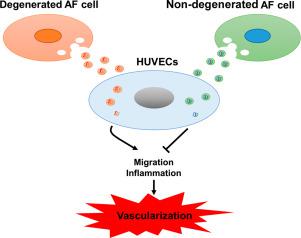Life Sciences ( IF 5.2 ) Pub Date : 2020-11-18 , DOI: 10.1016/j.lfs.2020.118778 Zhen Sun , Hang Zhao , Bing Liu , Yang Gao , Wen-Hao Tang , Zhi-Heng Liu , Zhuo-Jing Luo

|
Aims
The intervertebral disc is the largest avascular organ of the body. Vascularization of the disc has been typically regarded as a pathological feature of intervertebral disc degeneration (IDD). However, the underlying mechanism of vascularization in IDD is still unclear. The current study aimed to investigate the role of AF cell derived exosome (AF-exo) in the interaction with human umbilical vein endothelial cells (HUVECs) and its potential role in the regulation of vascularization in IDD.
Main methods
Human AF tissues were obtained from patients with IDD and idiopathic scoliosis. The AF-exo were isolated and identified by transmission electron microscopy (TEM), nanoparticle trafficking analysis (NTA) and Western blotting. Then, the AF-exo were used for HUVECs cultures. The migration of HUVECs was observed in 2D and 3D cultures. The inflammatory phenotype of HUVECs was examined by Real-time PCR and enzyme-linked immunosorbent assay (ELISA). Additionally, apoptosis of HUVECs were analyzed by flow cytometry.
Key findings
Here, we for the first time found that AF cells could secrete AF-exo and that the AF-exo could be phagocytosed by HUVECs. Additionally, we found that degenerated AF-exo exerted pro-vascularization effect on HUVECs by promoting cell migration (in 2D and 3D cultures) and inflammatory factor expression including IL-6, TNF-α, MMP-3, MMP-13 and VEGF, whereas the application of non-degenerated AF-exo demonstrated inverse effects.
Significance
These results showed that AF-exo is an essential regulator mediating intercellular communication between AF cells and HUVECs, suggesting its important role in vascularization in the intervertebral disc.
中文翻译:

AF细胞衍生的外来体调节内皮细胞迁移和炎症:椎间盘退变对血管形成的影响
目的
椎间盘是人体最大的无血管器官。椎间盘的血管化通常被认为是椎间盘退变(IDD)的病理特征。但是,IDD中血管形成的潜在机制仍不清楚。当前的研究旨在研究AF细胞衍生的外来体(AF-exo)在与人脐静脉内皮细胞(HUVEC)相互作用中的作用及其在调节IDD中血管形成中的潜在作用。
主要方法
人房颤组织取自IDD和特发性脊柱侧弯的患者。AF-exo分离并通过透射电子显微镜(TEM),纳米颗粒运输分析(NTA)和Western印迹进行鉴定。然后,将AF-exo用于HUVEC培养。在2D和3D文化中观察到HUVEC的迁移。HUVEC的炎症表型通过实时PCR和酶联免疫吸附测定(ELISA)进行检查。另外,通过流式细胞术分析了HUVEC的凋亡。
主要发现
在这里,我们首次发现AF细胞可以分泌AF-exo,而AF-exo可以被HUVEC吞噬。此外,我们发现简并的AF-exo通过促进细胞迁移(在2D和3D培养物中)和炎症因子表达(包括IL-6,TNF-α,MMP-3,MMP-13和VEGF)对HUVEC发挥促血管形成作用,而未退化的AF-exo的应用则显示出相反的效果。
意义
这些结果表明,AF-exo是介导AF细胞与HUVEC之间的细胞间通讯的重要调节剂,表明其在椎间盘血管化中的重要作用。











































 京公网安备 11010802027423号
京公网安备 11010802027423号